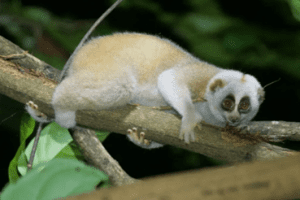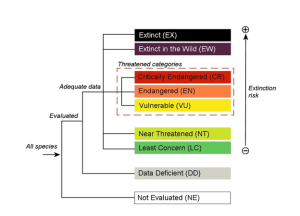TAG: GS 3: ECOLOGY AND ENVIRONMENT
THE CONTEXT: Villagers in Shimlabagan, located in the Shantipur area on the Indo-Bhutan border in Chirang, have reported the sighting of a rare species of the endangered primate Slow Lorris.
EXPLANATION:
- This marks the first known instance of this elusive primate being spotted in the region, particularly near the Jauhoulao National Park within the newly designated Chiknazha area.
- The local community, upon identifying the rare species, acted promptly to ensure its safety. The villagers took it upon themselves to notify the authorities and subsequently handed over the primate to the forest department at Shantipur.
About Slow Loris:
- It is found exclusively in South and Southeast Asia.
- Slow lorises are the world’s only venomous primates.
- They’re arboreal—meaning they live in trees—and can be spotted curling up to sleep in branches or using vines and leaves to get around.
- They typically only come down to the forest floor when they need to defecate.
- There are nine species of slow loris. They all belong to the same genus, with each species sharing many similar characteristics and behaviours.
- The nine species include the Philippine slow loris, Bengal slow loris, greater slow loris, Kayan slow loris, Bangka slow loris, Bornean slow loris, Sumatran slow loris, Javan slow loris, and pygmy slow loris.
- Bengal slow loris (Nycticebus bengalensis) is listed as Endangered in the IUCN Red List.
- It is also legally protected under the Wildlife Protection Act, 1972.
- The range of the Bengal slow loris extends from Vietnam to China, but in India, it is confined to India’s northeast.
Features of Slow Lorises:
- These small, nocturnal creatures are characterised by their large, round eyes, which are adapted for night vision.
- They have compact bodies, short snouts, dense fur, and distinctive facial markings.
- On average, they measure 20 to 37 centimetres (or 10 to 15 inches) long.
- Slow lorises each have a small bare patch under their arm that secretes oil. When they feel threatened, they lick this oil, which combines with their saliva tocreate a venom strong enough to kill small arthropods and mammals.
- Slow lorises are skilled hunters; they use their slow and deliberate movements to catch prey like insects and small vertebrates.
- They also have a specialised toothcomb—a unique structure created by their bottom front teeth—that they use for groomingand extracting gum from trees.
- Slow lorises are generally solitary and territorial animals. They have the ability to stay motionless for long periods.
- They are omnivores.

What are The IUCN Red List Categories and Criteria?
- The IUCN Red List Categories indicate how close a species is to becoming extinct.
- The nine Red List Categories are shown below:

- Species are assessed against five criteria (see below) based on geographic range, population size and population decline/increase, in addition to extinction probability analyses.
- These criteria determine which category is most appropriate for the species.

